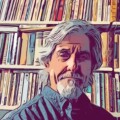News & Articles
Browse all content by date.

Duluth artist Wanda Pearcy is an assistant professor at the UMD’s College of Art and Design. Her work as an artist and photographer has garnered her much recognition and many awards. Her background includes painting, sculpture, and modern dance. She received her MFA at LSU in 1997.
EN: When did you first take an interest in the arts?
WP: Probably in high school when I took a class on Rembrandt. I also remember a great satisfaction from carving a hippo out of orange wax in high school. It wasn’t until I went to college that I thought of art as a lifestyle or a career.
EN: What prompted you to get your MFA?
WP: After I earned my BFA I spent a year teaching dance at Blue Water Dance and trying to find a job. After a year of searching, it was clear that I needed a higher degree. I saw the MFA as a driver’s license in the field of art. After I arrived and went through my first year of grad school, it became an intense journey into the history of sculpture and video/film arts.
EN: Later you gave up painting. What were the reasons behind this decision and where has it taken you?
WP: In grad school I sought after a process or a deliberate set of rules that would guide my art-making process. Due to postmodernism’s dismantling of the standard set of artistic rules artists used to make their work, it became necessary for each artist to create their own guidelines. The guidelines I developed became an art series called “Art as Life.” This series started with a physical process of transforming my oil paintings: literally dismantling them strand by strand, hand shredding them, and then restructuring them into sculpture. In the end, this series developed a set of rules that I would follow to allow my art to fit the lifestyle and value choices that I live by. I created a life-sized game board that included my rules of what to make and expect from art, which included the following text:
THE GAME OF ART
Player One
OBJECTIVE: Create art that is not in conflict with how one lives, how one thinks, who one is and the reality in which one lives.
In my life environmental concerns were increasingly becoming the foundation of how I lived and what I thought about and what type of changes I wanted to make in my life. After some deep thought about what I could commit to as a process for making art, oil painting didn’t seem to feed me due to its toxic nature. I still loved it and what it could produce and feed me spiritually, but the conflict was too great and I started experimenting with how I could transform my work process and my life process to fit this new creed.
As I continue examining ways to make art that fit my desires for transformation, I am working on Earthworks as a way to integrate my life and my art.
EN: Conceptual art and minimalism seemed like endpoints of a history that began with Duchamp’s readymades. Now it seems like creative expression has exploded into whole new territories. What do you see happening in the arts as we begin the second decade of the 21st century?
WP: Technology has changed our relationship to the earth and to the art experience. Much of the art we see today has a sense of distance due to the distance between the art and the maker via the tools that are used to create—most of us no longer use the hand in the way that we have in the past. When I start framing an image with my camera, I am pushing buttons that have an intended purpose. It is not the same as pushing charcoal across the page in an intuitive process. More of the mind is in the art process. I would say that less of the heart in a direct connection to expression has taken a silent step back. I hope to see artists re-examining art without machines in new ways. As long as the machine is the way we live, travel, communicate, etc., it will always be in our art.
EN: 2012 is the hundred-year anniversary of Duchamp’s Nude Descending a Staircase. Who are your heroes in the art scene today?
WP: Roman Signer – beautiful simplicity that is full of depth and questions the absurdity of the pace of the technical being. Anne Arden McDonald – the body in the landscape. Wolfgang Laib – spiritual guest in the landscape. Francesca Woodman – innocent playfulness. Anna Mendieta – use of the body in the landscape. Robert and Shanna ParkeHarrison – I love their commitment to a sense of ecological heroism.
EN: What are some of your other sources of inspiration?
WP: Plant life underground has been my main study in the past seven years as I grew my garden, and it is now entering my art-work. I do foresee it becoming the focus of my work and I move toward documenting symbiotic landscapes. The title of my new series is “symbiotic landscape.” I also have a “dreamscape” series in the works that is heavily influenced by my time in the natural world.
| Tweet |


